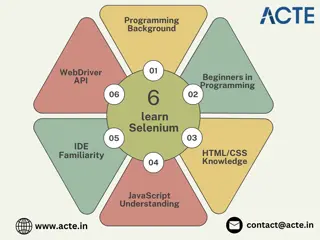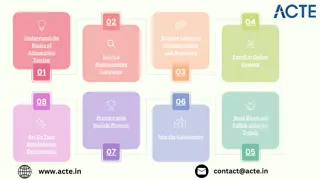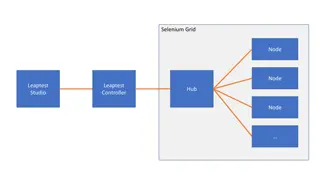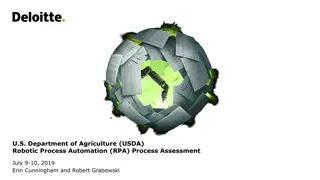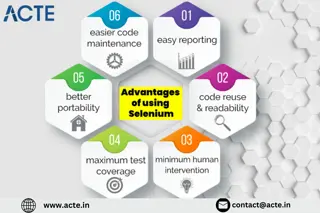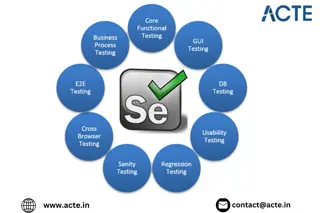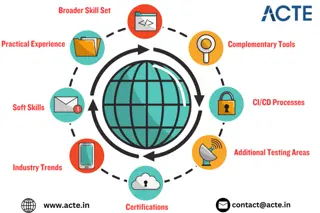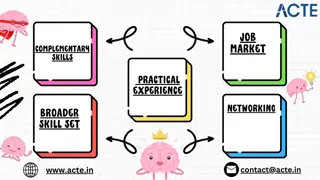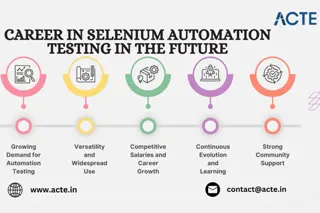Introduction to Test Automation with Selenium
Selenium is a powerful tool that automates browsers, primarily used for testing web applications but not limited to that. It is supported by major browser vendors and is the core technology in various automation tools and frameworks. Selenium includes components like Selenium IDE, Selenium 1.0, Selenium Remote Control (RC), Selenium Grid, and the newer Selenium WebDriver, offering capabilities for efficient web testing. Utilize Selenium to automate tasks, improve testing efficiency, and enhance web application quality.
Download Presentation

Please find below an Image/Link to download the presentation.
The content on the website is provided AS IS for your information and personal use only. It may not be sold, licensed, or shared on other websites without obtaining consent from the author.If you encounter any issues during the download, it is possible that the publisher has removed the file from their server.
You are allowed to download the files provided on this website for personal or commercial use, subject to the condition that they are used lawfully. All files are the property of their respective owners.
The content on the website is provided AS IS for your information and personal use only. It may not be sold, licensed, or shared on other websites without obtaining consent from the author.
E N D
Presentation Transcript
Test Automation with Selenium
Selenium Selenium automates browsers. That's it. What you do with that power is entirely up to you. Primarily it is for automating web applications for testing purposes, but is certainly not limited to just that. Boring web-based administration tasks can (and should!) also be automated as well. Selenium has the support of some of the largest browser vendors who have taken (or are taking) steps to make Selenium a native part of their browser. It is also the core technology in countless other browser automation tools, APIs and frameworks. Source: http://www.seleniumhq.org/
Selenium IDE Start and Stop Recording Selenium IDE is a Firefox plugin which records and plays back user interactions browser. Use this create simple scripts or assist in exploratory testing. with to either the Script Editor It Control or WebDriver scripts, though they somewhat brittle and should be overhauled into some sort of Page Object-y structure for any kind of resiliency. can also export Remote tend to be Selenium Log
Selenium 1.0 Remote Control Selenium RC was the main Selenium project for a long time, before the WebDriver/Selenium merge brought up Selenium 2, the newest and more powerful tool. Selenium 1 is still actively supported (mostly in maintenance mode) and provides some features that may not be available in Selenium 2 for a while, including support for several languages (Java, Javascript, Ruby, PHP, Python, Perl and C#) and support for almost every browser out there.
Selenium 1.0 Grid Selenium-Grid allows the Selenium RC solution to scale for large test suites and for test suites that must be run in multiple environments. Selenium Grid allows you to run your tests in parallel, that is, different tests can be run at the same time on different remote machines. This additional server piece allows the several Remote Control accessed in parallel by one or more driving processes. You may want to do this if you want to use scale to speed everything up, or because you need to test on Mac and/or Linux, as well as Windows from one driving test-suite. servers to
Selenium 2.0 WebDriver The primary new feature in Selenium 2.0 is the integration of the WebDriver API. WebDriver is designed to provide a simpler, more concise programming interface in addition to addressing some limitations in the Selenium-RC API. Selenium WebDriver was developed to better support dynamic web pages where elements of a page may change without the page itself being reloaded. WebDriver s goal is to supply a well-designed object-oriented API that provides improved support for modern advanced web-app testing problems.
Selenium 1.0 vs. 2.0 Selenium WebDriver makes direct calls to the browser using each browser s native support for automation. For those familiar with Selenium-RC, this is quite different from what you are used to. Selenium-RC worked the same way for each supported browser. It injected javascript functions into the browser when the browser was loaded and then used its javascript to drive the AUT within the browser. WebDriver does not use this technique. Again, it drives the browser directly using the browser s built in support for automation.
Selenium WebDriver Development Environment IntelliJ, development environment JUnit, unit testing framework Maven, build tool
IntelliJ IntelliJ IDEA is a Java IDE by JetBrains, available as an Apache 2 Licensed community edition and commercial edition. It is often simply referred to as "IDEA" or "IntelliJ"
JUnit JUnit is a unit testing framework for the Java programming language. JUnit has been important in the development of test-driven development, and is one of a family of unit testing frameworks which is collectively known as xUnit that originated with SUnit. JUnit is linked as a JAR at compile-time; the framework resides under package junit.framework for JUnit 3.8 and earlier, and under package org.junit for JUnit 4 and later. A JUnit test fixture is a Java object. With older versions of JUnit, fixtures had to inherit from junit.framework.TestCase, but the new tests using JUnit 4 should not do this. Test methods must be annotated by the @Test annotation.
JUnit If you do not use IDE, add a method suite() , it automatically creates a test suite including all test methods. Then add a main method and use textui runner run all test cases.
Maven Maven is a build automation tool used primarily for Java projects. Maven serves a similar purpose to the Apache Ant tool, but it is based on different concepts and works in a different manner. Maven uses an XML file to describe the software project being built, its dependencies on other external modules and components, the build order, directories, and required plug- ins. It comes with pre-defined targets for performing certain well-defined tasks such as compilation of code and its packaging. Maven dynamically downloads Java libraries and Maven plug-ins from one or more repositories such as the Maven 2 Central Repository, and stores them in a local cache. This local cache of downloaded artifacts can also be updated with artifacts created by local projects. Public repositories can also be updated. .
Maven Maven projects are configured using a Project Object Model, which is stored in a pom.xml-file. This unique project (coordinates) and its dependency on framework. POM only defines for a identifier the the JUnit However, enough for building the project and running the unit tests associated with the project. that is already Maven accomplishes this by embracing the Convention Configuration, that is, Maven provides default values for the project's configuration. idea of over
Maven The directory structure of a normal idiomatic Maven project has the following directory entries:
Selenium Webdriver Getting Started How to create a simple Selenium Webdriver test using Java, IntelliJ, Junit and Maven
Contact Bize Ula n info@keytorc.com blogs.keytorc.com tr.linkedin.com/in/keytorc www.twitter.com/Keytorc Keytorc Software Testing Services








